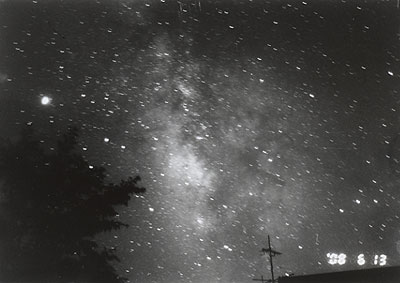June 29
On June 27 it rained heavily in the eastern part of Kochi
prefecture, particularly around Aki city. We were worried about possible
damage to the observatory building because the area of the heaviest rain
happened to be where the observatory was located. Mr. Shimomoto checked
the observatory during the daytime of June 28 and found that rainwater
had found its way through a small opening between the slit and dome to
wet the telescope and some part of the floor covering . He cleaned the
dome carefully and left for home as the weather was not very good that
night, while I headed for the observatory believing it would clear up late
at night. It was a complete surprise when I ran into Mr. Shimomoto at a
service station on my way to the observatory.
Occasionally, my weather forecast turns out to be right.
At the observatory the sky began clearing up rapidly around 22.00 revealing
the magnificent Milky Way (as seen in the photograph) running from north
to south. Particularly, the sky around Sagittarius where Jupiter was positioned
was awesome. Mesmerized, I just stared at the sky for some time thinking
that in the sky like this there could be a nova shining somewhere.
Before the dawn C/2007 (Boattini) is expected to become visible
at 6th magnitude low in the eastern sky, but its altitude is 0 at the start
of twilight and it is well behind the forest in the east. Once it has cleared
the forest, the comet could be a magnificent sight as its distance from
the earth is small.

20-minute exposure from 23:30 on June 29, 2008
Nikkor 28mm F4, TMY 400 film
On June 12, the president of Nishimura Optical Company of
Kyoto, manufacturer of Geisei's 70cm reflector, met at Kochi University
of Technology with people involved in this telescope project to discuss
the future improvements. I believe that there is no perfect telescope at
the moment of installation and that problems can be corrected one by one
for perfection only by joint efforts between the manufacturer and observers.
At this meeting the problems raised were one of the f-ratio dependent on
the position of the reducer lens and vignetting caused by the diagonal
mirror. They discussed how these problems could be resolved.
At night we had a clear sky briefly, perhaps a break in
the rainy season, and tested the CCD until late at night with Mr. Shimomoto,
a staff member of Geisei. There were clouds hanging around at first, but
after Mr. Shimomoto left for home, the clouds began clearing from the west
and by dawn it turned to a magnificent starry sky.

The 70cm reflector during observation
The Milky Way was awesome and appeared three-dimensional.
From the dome I photographed known visible comets for astrometry. For 30
minutes to the dawn I searched the eastern sky with 15cm binoculars.
The beauty of the stars projected through the fast lens is
beyond words. Only when you are searching through a comet seeker, you can
really appreciate the true beauty of the heavens. The Double Cluster in
Perseus appeared to be star dust pouring out of a jewel box. M33 in Triangulum
was diffused and extensive, looking like a swirling smoke, reminiscent
of Comet Holmes observed earlier. I estimated the total magnitude of the
comet to be five.
A photograph of the constellations like the one below is
made using monochrome film (which I favor most) during an observing session.

The Milky Way seen outside the dome
Nikon F80 35mm f/2, 60-second exposure, TX 400 film



